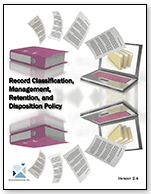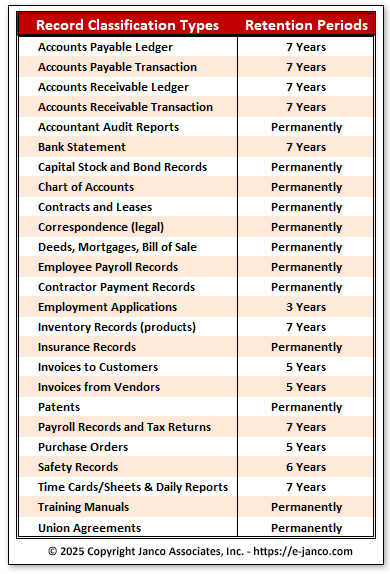Record Management Life Cycle
Order Record Management Policy Download Selected Pages Version History
The Janco Record Classification and Management Policy Templeate deals with all aspects of tthe records management lifecycle:
-
 Manage data growth. Archive inactive data simply and safely, reducing the burden on yourcritical business systems and ensuring your IT organization's ability to meet service level agreements. At the same time, reduce your company's overall storage footprint. As a result, your company can more readily contain the costs of hardware, databases, and packaged applications, as well as administration and maintenance.
Manage data growth. Archive inactive data simply and safely, reducing the burden on yourcritical business systems and ensuring your IT organization's ability to meet service level agreements. At the same time, reduce your company's overall storage footprint. As a result, your company can more readily contain the costs of hardware, databases, and packaged applications, as well as administration and maintenance.
- Optimize test data management. Developing, deploying, updating, and managing enterprise business applications means testing them repeatedly using multiple, representative, real-world test data sets - typically as a complete copy of the production database. Making multiple full copies of large production databases consumes valuable database and storage capacity. Your IT organization should optimize the test data management environment to control runaway data management costs by creating fully functional "lean" copies that are as much as 75 percent smaller than the full production database.
- Support regulatory compliance. Depending on your company's location, industry, and type of data, you may be required by law to retain business-critical data for a decade or more. Retain data for a longer period in more costeffective storage. At the same time, ensure that your IT organization can access that archived data on demand, so that your business can respond promptly and easily to audit requests.
- Protect sensitive data. An estimated 60 percent of companies copy production data into nonproduction systems for development, testing, and other needs, compromising data confidentiality. Masks nonproduction data, while maintaining its referential integrity and keeping the data characteristics intact. developrs, QA personnel, trainers, and others can effectively use the realistic yet masked data while staying in compliance with internal, industry, and governmental data privacy mandates and regulations.
- Support corporate divestitures and reorganizations. To shed less-profitable parts of your business or realign business units to better fit your overall business strategy, your company needs to remove the divested or realigned business unit's data. Efficiently separate functionally related data from complex transactional systems, allowing the new organization to become operational faster and to realize quicker time to value.
- Safely retire legacy systems and applications. As your business grows or as you acquire additional companies, legacy applications may start to proliferate in your IT environment. These legacy applications are rarely used and most have little ongoing business value. However, they continue to be maintained for compliance reasons, incurring significantly high software license, hardware, power, and maintenance costs. Reduce costs by allowing the application and the supporting hardware and software stack to be shut down, thereby saving on license, maintenance, and administration costs.
Record Classification and Management Template Includes Citations for Federal and Selected State Record Retention Requirements
A record is essentially any material that contains information about your company's plans, results, policies or performance. In other words, anything about your company that can be represented with words or numbers can be considered a business record - and you are now expected to retain and manage every one of those records, for several years or even permanently depending on the nature of the information. The need to manage potentially millions of records each year creates many new challenges for your business, and especially for your IT managers who must come up with rock-solid solutions to securely store and manage all this data.
The Record Classification, Management, Retention, and Destruction policy is a detail template which can be utilized on day one to create a records management process. Included with the policy are forms for establishing the record management retention and destruction schedule and a full job description with responsibilities for the Manager Records Administration.

Unitied States Employers have a number of record retention requirments that are mandated by the federal government.
The areas included with this policy template are:
- Record retention requirements for SOX sections 103a, 302, 404, 409, 801a and 802.
- Policy
- Standard
- Scope
- Responsibilities
- Record Management Policy
- Compliance and Enforcement
- E-mail Retention and Compliance
- Job Description Manager Record Administrator
- 12 forms for Record Retention and Disposition Schedule
- Record Management Best Practices
- Employee Record Retention Federal Requirements
Managing backup and recovery in today's environment is a multi-dimensional challenge with both near and long term business requirements. Recent technological developments in disk backup have had a positive impact on short term data retention requirements. But these improvements do not replace the need to execute and deliver on a long term data retention strategy which includes:
- Business and Regulatory Requirements Demand a Long-term Plan
- Manage and Contain Your Total Cost of Ownership (TCO)
- Encrypt Your Data for Secure Long-term Retention
- Weigh the Environmental Impacts and Minimize Power and Cooling Costs
- Simplify Management of the Entire Solution
Order Record Management Policy Download Selected Pages Version History
Other Policies
All of the policies that are provided here are contained within one or more of the templates that are on this site. These policies have been added as individual documents in MS WORD format for those clients who just need this particular policy. All policies are Sarbanes-Oxley, HIPAA, PCI-DSS, and ISO compliant.
The policies have just been updated to comply with all mandated requirements and include electronic forms that can be Emailed, filled out completely on the computer, routed and stored electronically -- a total solution.
We have just completed a major update of all the individual polices and all of the electronic forms.
- CIO IT Infrastructure Policy Bundle (All of the policies below are included as individual MS Word files and a single PDF file. Electronic forms are all individual documents that are easily modifiable)
- Backup and Backup Retention Policy
- Blog and Personal Web Site Policy (Includes electronic Blog Compliance Agreement Form)
- BYOD Policy Template (Includes electronic BYOD Access and Use Agreement Form)
- Google Glass Policy (Includes Google Glass Access and Use Agreement Form)
- Incident Communication Plan Policy (Updated to include pandemic considerations and social networks as a communication path)
- Internet, e-mail, Social Networking, Mobile Device, Electronic Communications, and Record Retention Policy(Includes 5 electronic forms to aid in the quick deployment of this policy)
- Mobile Device Access and Use Policy
- Patch Management Policy
- Outsourcing and Cloud Based File Sharing Policy
- Physical and Virtual Server Security Policy
- Privacy Compliance Policy - California Privacy Act
- Record Classification, Management, Retention, and Destruction Policy
- Safety Program (Includes mandated OSHA electronic forms)
- Sensitive Information Policy (CCPA, GDPR & HIPAA Compliant and includes electronic Sensitive Information Policy Compliance Agreement Form)
- Service Level Agreement (SLA) Policy Template with KPI Metrics
- Social Networking Policy (includes electronic form)
- Technology Acquisition Policy
- Text Messaging Sensitive and Confidential Information (includes electronic form)
- Travel, Electronic Meeting, and Off-Site Meeting Policy
- Wearable Device Policy
- WFH & Telecommuting Policy (includes 8 electronic forms to effectively manage work at home staff)
- IT Infrastructure Electronic Forms

